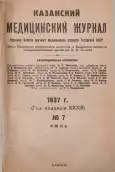Pignot. Симптоматология и терапия стригущих лишаев. Presse Med., № 20, 10.III 1937 г.)
- Авторы: Дембская В.
- Выпуск: Том 33, № 7 (1937)
- Страницы: 936-936
- Тип: Статьи
- URL: https://bakhtiniada.ru/kazanmedj/article/view/75534
- DOI: https://doi.org/10.17816/kazmj75534
- ID: 75534
Цитировать
Полный текст
Аннотация
Чтобы лучше рассмотреть заболевшие волосы надо поставить голову между тенью и светом так, чтобы этот последний скользил по ней. Иногда пораженные лишаем волосы скрываются под корками. Эти корки облегчают находку пораженных волос. При микроспорионе волос представляется как бы покрытым инеем, при эндоспорионе он имеет вид запятой, его обломки глубоко вкраплены в густую корку. Эти признаки касаются уже развившегося заболевания. Волос, пораженный микроспорионом, имеет под микроскопом вид стеклянной палочки, опущенной в клей и вывалянной в песке. При эндотрихофитии же он весь пронизан нитями спор, напоминая мешок, наполненный орехами, причем паразит не переходит за пределы эпидермикула волосяного стержня. При керионе встречаются паразиты, весьма напоминающие микроспорион, но они еще более мелки, почему их и называли микроидами. Как и при микроспорионе они образуют как бы футляр вокруг волоса с той только разницей, что здесь споры лежат в виде нитей, а не в виде мозаики. В значительно более редких случаях встречаются паразиты типа эндо - экзотрикс, которые наполняют внутренность волоса и в то же время выходят за пределы эпидермикула, образуя вокруг него как бы футляр из очень крупных спор (мегаспоры).
Ключевые слова
Полный текст
Открыть статью на сайте журналаСписок литературы
Дополнительные файлы






